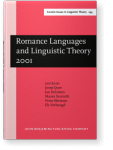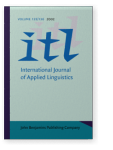Karen Lahousse
List of John Benjamins publications for which Karen Lahousse plays a role.
Journals
ISSN 0035-3906 | E-ISSN 1600-0811
Non-prototypical clefts
Edited by Lena Karssenberg, Karen Lahousse, Béatrice Lamiroy, Stefania Marzo and Ana Drobnjakovic
[Belgian Journal of Linguistics, 32] 2018. v, 169 pp.
Subjects Theoretical linguistics
Non-Nuclear Cases
Edited by Nicole Delbecque, Karen Lahousse and Willy Van Langendonck
[Case and Grammatical Relations Across Languages, 6] 2014. xii, 328 pp.
Subjects Syntax | Theoretical linguistics
Romance Languages and Linguistic Theory 2012: Selected papers from 'Going Romance' Leuven 2012
Edited by Karen Lahousse and Stefania Marzo
[Romance Languages and Linguistic Theory, 6] 2014. xiii, 247 pp.
Subjects Generative linguistics | Romance linguistics | Theoretical linguistics
French Syntax in Contrast
Edited by Karen Lahousse, Béatrice Lamiroy and Kristel Van Goethem
Special issue of Lingvisticæ Investigationes 33:2 (2010) vi, 170 pp.
Subjects Computational & corpus linguistics | Generative linguistics | Lexicography | Romance linguistics | Syntax | Theoretical linguistics
2025 Syntactic position of contrast markers in different registers of French International Journal of Corpus Linguistics: Online-First Articles | Article
This paper presents a quantitative corpus analysis of three syntactically mobile contrast markers in different registers of French: contrastive adverbs, emphatic pronouns, and emphatic pronouns introduced by quant à “as for”. We show that the preferred syntactic position of the three markers is… read more
2023 Chapter 5. Presentational clefts, existentials and information structure: A comparative perspective on French and Italian Existential Constructions across Languages: Forms, meanings and functions, Sarda, Laure and Ludovica Lena (eds.), pp. 139–179 | Chapter
Presentational c’è / il y a clefts in Italian and French have been argued to differ from the existential and locative constructions they derive from by their syntactic, semantic and information-structural properties: they would invariably convey sentence-focus. In the present study, we argue for… read more
2022 Is focus a root phenomenon? When Data Challenges Theory: Unexpected and paradoxical evidence in information structure, Garassino, Davide and Daniel Jacob (eds.), pp. 147–182 | Chapter
This article argues that some types of syntactically marked focus are root (main clause) phenomena in French. We show that c’est (‘it is’) clefts, which explicitly mark narrow new information focus, are root phenomena, in contrast with il y a (‘there is’) clefts marking broad new information focus… read more
2018 Les clivées en voici / voilà: Une analyse de corpus Lingvisticæ Investigationes 41:1, pp. 129–151 | Squib
Cet article est consacré à trois types de clivées en voici/voilà (type 1 : voilà le chat qui arrive, type 2 : le voilà qui arrive, type 3 : voilà deux semaines que j’attends). Nous analysons (i) l’alternance entre voici et voilà, (ii) la distribution des trois types dans deux corpus, (iii)… read more
2018 Non-prototypical clefts: Formal, semantic and information-structural properties Non-prototypical clefts, Karssenberg, Lena, Karen Lahousse, Béatrice Lamiroy, Stefania Marzo and Ana Drobnjakovic (eds.), pp. 1–20 | Introduction
In this article we present an overview of current debates in the analysis of cleft sentences. The types of sentences that are often seen as prototypical examples of the cleft category are introduced by it is or a cross-linguistic equivalent; in addition, they have specificational semantics and a… read more
2015 Review of Kragh & Lindschouw (): Deixis and Pronouns in Romance Languages Lingvisticæ Investigationes 38:1, pp. 183–187 | Review
2015 A case of focal adverb preposing in French Structures, Strategies and Beyond: Studies in honour of Adriana Belletti, Di Domenico, Elisa, Cornelia Hamann and Simona Matteini (eds.), pp. 209–236 | Article
This article is about a specific case of focal adverb preposing in French, i.e. preposing of the adverb ainsi ‘in this way’, which is necessarily followed by subject inversion, resulting in the word order [focal ainsi – V – S]. This construction appears in a very specific discourse context and,… read more
2014 Nuclear and Non-Nuclear Cases: A Continuum Non-Nuclear Cases, Delbecque, Nicole, Karen Lahousse and Willy Van Langendonck (eds.), pp. 1–20 | Article
We first briefly present the terminology and criteria which are commonly used in the linguistic literature in relation with the distinction between nuclear cases and non-nuclear cases. We emphasize the specific position obliques occupy with respect to these criteria and give a short overview on how… read more
2014 Issues in Romance Languages and Linguistic Theory Romance Languages and Linguistic Theory 2012: Selected papers from 'Going Romance' Leuven 2012, Lahousse, Karen and Stefania Marzo (eds.), pp. vii–xiv | Article
2013 Binding at the syntax-information structure interface Information Structure and Agreement, Camacho-Taboada, Victoria, Ángel L. Jiménez-Fernández, Javier Martín-González and Mariano Reyes-Tejedor (eds.), pp. 141–174 | Article
This article argues for a cartographic analysis of binding, which preserves a syntactic approach in terms of c-command and incorporates information structure. We claim that an extensive account of the binding effects must integrate a sentence structural configuration where Topic always projects at… read more
2010 Information structure and epistemic modality in adverbial clauses in French Studies in Language 34:2, pp. 298–326 | Article
In this paper it is argued that, contrary to what is often assumed, embedded adverbial clauses have an information structure articulation independent from that of the main clause. More particularly, it is shown that the specific way in which information structure is expressed in adverbial clauses… read more
2006 L’assertion et l’inversion du sujet nominal dans les subordonnées adverbiales Ordre des mots et topologie de la phrase française, Gerdes, Kim et Claude Muller (dir.), pp. 113–124 | Article
In this article we show that the distribution of nominal inversion is not the same in all types of embedded adverbial clauses. We present a new descriptive generalization according to which the appearance of postverbal subjects must necessarily be favoured by the presence of a spatio-temporal… read more
2005 ‘Focus VS’: A Special Type of French NP subject inversion Romance Languages and Linguistic Theory 2003: Selected papers from ‘Going Romance’ 2003, Nijmegen, 20–22 November, Geerts, Twan, Ivo van Ginneken and Haike Jacobs (eds.), pp. 161–176 | Article
2003 On the Non-Unitariness of NP Subject Inversion: A Comparison of French NP Subject Inversion in Interrogatives and Temporal Subordinates Romance Languages and Linguistic Theory 2001: Selected papers from 'Going Romance', Amsterdam, 6–8 December 2001, Quer, Josep, Jan Schroten, Mauro Scorretti, Petra Sleeman and Els Verheugd-Daatzelaar (eds.), pp. 177–192 | Article
2003 NP-Subject Inversion in French and (Preposed) Adverbs Romance Linguistics: Theory and Acquisition, Pérez-Leroux, Ana Teresa and Yves Roberge (eds.), pp. 181–196 | Article
2003 La distribution de l’inversion nominale en français dans les principales non interrogatives et les subordonnées circonstan Grammaires et Lexiques Comparés: Actes du Colloque, Conenna, Mirella and Éric Laporte (eds.), pp. 123–158 | Article
Summary This article deals with the distribution of nominal inversion in non-interrogative main clauses and embedded adverbial clauses in French. As for main clauses, it is established that nominal inversion occurs when the clause contains a stage topic, i.e. a spatio-temporal location, whether… read more


















